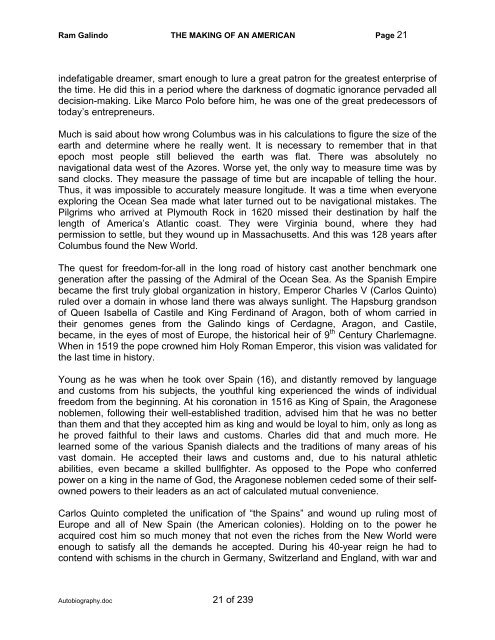Autobiography - The Galindo Group
Autobiography - The Galindo Group
Autobiography - The Galindo Group
Create successful ePaper yourself
Turn your PDF publications into a flip-book with our unique Google optimized e-Paper software.
Ram <strong>Galindo</strong> THE MAKING OF AN AMERICAN Page 21<br />
indefatigable dreamer, smart enough to lure a great patron for the greatest enterprise of<br />
the time. He did this in a period where the darkness of dogmatic ignorance pervaded all<br />
decision-making. Like Marco Polo before him, he was one of the great predecessors of<br />
today’s entrepreneurs.<br />
Much is said about how wrong Columbus was in his calculations to figure the size of the<br />
earth and determine where he really went. It is necessary to remember that in that<br />
epoch most people still believed the earth was flat. <strong>The</strong>re was absolutely no<br />
navigational data west of the Azores. Worse yet, the only way to measure time was by<br />
sand clocks. <strong>The</strong>y measure the passage of time but are incapable of telling the hour.<br />
Thus, it was impossible to accurately measure longitude. It was a time when everyone<br />
exploring the Ocean Sea made what later turned out to be navigational mistakes. <strong>The</strong><br />
Pilgrims who arrived at Plymouth Rock in 1620 missed their destination by half the<br />
length of America’s Atlantic coast. <strong>The</strong>y were Virginia bound, where they had<br />
permission to settle, but they wound up in Massachusetts. And this was 128 years after<br />
Columbus found the New World.<br />
<strong>The</strong> quest for freedom-for-all in the long road of history cast another benchmark one<br />
generation after the passing of the Admiral of the Ocean Sea. As the Spanish Empire<br />
became the first truly global organization in history, Emperor Charles V (Carlos Quinto)<br />
ruled over a domain in whose land there was always sunlight. <strong>The</strong> Hapsburg grandson<br />
of Queen Isabella of Castile and King Ferdinand of Aragon, both of whom carried in<br />
their genomes genes from the <strong>Galindo</strong> kings of Cerdagne, Aragon, and Castile,<br />
became, in the eyes of most of Europe, the historical heir of 9 th Century Charlemagne.<br />
When in 1519 the pope crowned him Holy Roman Emperor, this vision was validated for<br />
the last time in history.<br />
Young as he was when he took over Spain (16), and distantly removed by language<br />
and customs from his subjects, the youthful king experienced the winds of individual<br />
freedom from the beginning. At his coronation in 1516 as King of Spain, the Aragonese<br />
noblemen, following their well-established tradition, advised him that he was no better<br />
than them and that they accepted him as king and would be loyal to him, only as long as<br />
he proved faithful to their laws and customs. Charles did that and much more. He<br />
learned some of the various Spanish dialects and the traditions of many areas of his<br />
vast domain. He accepted their laws and customs and, due to his natural athletic<br />
abilities, even became a skilled bullfighter. As opposed to the Pope who conferred<br />
power on a king in the name of God, the Aragonese noblemen ceded some of their selfowned<br />
powers to their leaders as an act of calculated mutual convenience.<br />
Carlos Quinto completed the unification of “the Spains” and wound up ruling most of<br />
Europe and all of New Spain (the American colonies). Holding on to the power he<br />
acquired cost him so much money that not even the riches from the New World were<br />
enough to satisfy all the demands he accepted. During his 40-year reign he had to<br />
contend with schisms in the church in Germany, Switzerland and England, with war and<br />
<strong>Autobiography</strong>.doc 21 of 239


